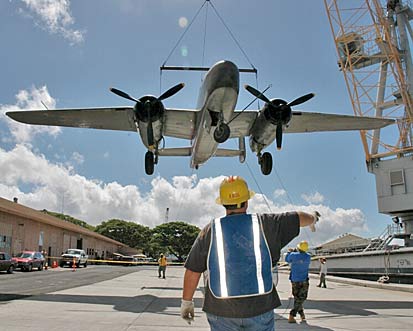
|
Noted WWII bomber
arrives for museum
The military aviation exhibit
at Ford Island is expected
to open next year
The $50 million Pacific Aviation Museum at Ford Island received its first warbird yesterday as organizers work toward unveiling the museum's first exhibits on Dec. 7, 2006, the 65th anniversary of the attack on Pearl Harbor.
Flying history
What: Pacific Aviation Museum
Location: Ford Island Opening date: Dec. 7, 2006 Scope: Pre-World War II aviation through the Cold War Projected cost: $50 million Already raised: $11 million Web site: pacificaviationmuseum.org
B-25 Mitchell bomber
More than 9,800 B-25s were built during World War II.
Length: 52 feet, 11 inches
|
Palmer, a retired Air Force and Navy Vietnam combat pilot, said by the time the museum's first building, Hanger 37, opens in 2006 there will be at least nine aircraft on display.
Besides the 52-foot B-25 bomber, Palmer said the museum owns eight other aircraft that it will use to tell the story of naval aviation in the Pacific beginning just before World War II and extending through the Cold War. These aircraft include the Boeing Stearman that President George H.W. Bush learned to fly as he became the youngest aviator in World War II, Palmer added.
Other aircraft in the museum's inventory are a MiG-15, an F-86 Sabre jet from the Korean War, which was flown and donated by the Hawaii Air National Guard, former Hawaii Army National Guard UH-1 Huey and AH-6 Cobra helicopters to represent the Vietnam War, and the Aeronca biplane that was airborne on Dec. 7, 1941, with an instructor pilot and a civilian student.
"It flew right into the first wave of Japanese fighters," Palmer said, "and the bullet holes in its tail still can be seen today."
Palmer said that he doesn't know much about the history of the B-25 bomber, except that it was originally brought here during the filming of the 1970 movie "Tora Tora Tora," about the attack on Pearl Harbor.
After the filming, the bomber was on display in front of the 15th Airlift Wing's headquarters building at Hickam Air Force Base. Museum board member John Sterling coordinated the use of the 175-foot floating crane and the tugboat Kaimana Hila.
Palmer said the development of the museum, on 16 acres of Ford Island, will be done in phases with completion within three years. The museum will encompass three hangers and the red and white control tower.
The 42,442-square-foot Hanger 37 will be developed first because it is in fairly good shape, Palmer added.
"The hanger is currently being used as a gym by the military," Palmer said. "The building is good and the roof is solid."
Half of the space in Hanger 37 will be converted into an area that will house a restaurant, theater, and museum store. It is part of phase one, which is expected to be completed next year and will cost $6 million. That will be followed with the renovation of the 85,760-square-foot Hanger 79; 76,0699-square-foot Hanger 54; and the 8,886-square-foot control tower, at a cost of $44 million.
Of the estimated $50 million to build the museum complex, $6 million will be raised within Hawaii. So far, the state Legislature appropriated $1 million this year and another $2.6 million has come from private donors in Hawaii. Palmer said U.S. Sen. Daniel Inouye has also secured an $8 million Pentagon grant for the project.
Although initially most of the aircraft will be in, or displayed around, Hanger 37, they will be relocated to the two other hangers when the museum complex is completed, Palmer said.
E-mail to City Desk
[News] [Business] [Features] [Sports] [Editorial] [Do It Electric!]
[Classified Ads] [Search] [Subscribe] [Info] [Letter to Editor]
[Feedback]
